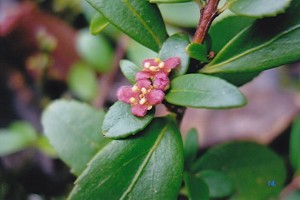
News/Reports
Stoyoma Creek ER #131 Overview, Biological and Physical
Original Purpose
To protect a floristically diverse forest site, transitional between coastal and interior conditions, for forestry research.
Physical: The reserve is located on the west slope of the Cascade Mountains, an area of strongly folded and metamorphosed Palaeozoic and Mesozoic sedimentary and volcanic rocks. Its soils are primarily Humo-Ferric Podzols formed on glacial till. The reserve faces west-northwest and has an average slope of about 25o. The climate is transitional between humid coastal and dry interior regimes.
See the full PDF: Stoyoma Creek ER 131-2
Biological: Stoyoma Creek Ecological Reserve is entirely forested and supports a considerable diversity of trees and understory plants due to its transitional location. Both coastal and interior species occur, however, the former are most common.
Most of the reserve is in the moist submaritime subzone of the Coastal Western Hemlock Zone. Western hemlock, western redcedar, Douglas-fir and amabilis fir are all well represented; typical shrubs include devil’s club and black huckleberry; common herbaceous species are rosy twistedstalk, star-flowered false Solomon’s-seal, Hooker’s fairybells, queen’s cup, bunchberry and oak fern. Moss cover is well developed. Poor, dry sites in this subzone have a higher proportion of Douglas-fir and lodgepole pine and support shrubs like falsebox, soopolallie, Saskatoon and birch-leaved spirea.
At its highest elevations the reserve is within the moist warm subzone of the Engelmann Spruce-Subalpine Fir Zone. Subalpine fir dominates the forest cover, but amabilis fir, Engelmann spruce and Douglas-fir also occur. Black huckleberry and thimbleberry are common shrubs; typical forbs include western meadowrue, Sitka valerian, great northern aster and mountain arnica.
Preliminary reconnaissance has revealed nine species of conifers, two deciduous
trees (red alder and paper birch), 23 shrubs, 72 herbaceous plants and 16 bryophytes in the reserve.
Birds seen in the reserve include Hermit Thrush; MacGillivray’s, Townsend’s and Yellow-rumped Warblers; Dark-eyed Junco; Gray Jay; White-winged Crossbill; Pine Siskin; Raven; and American Kestrel.
SIGNIFICANT SPECIES BC LIST STATUS
Mountain Beaver, ssp. rainieri Cosewic Status: Blue listed Special Concern (1999)
THREATS
Climate Change:Representation of such diversity may be reduced in this reserve due to changing climatic envelopes and shifting ecosystems as a result of climate change. The Engelmann Spruce-Subalpine Fir zone may be displaced or driven up-slope by expanding Douglas- fir forest systems.
Invasive species: Knapweed and thistles introduced by vehicle traffic.
RESEARCH OPPORTUNITIES
The reserve contains special provenances of several coniferous trees and is a valuable site for cone collection. A plant list is available.
SCIENTIFIC NAMES OF SPECIES MENTIONED IN THE STOYOMA CREEK ER ACCOUNT
alder, red (Alnus rubra)
arnica, mountain (Arnica latifolia)
aster, great northern (Aster modestus)
birch, paper (Betula papyrifera var. commutata and var. papyrifera)
bunchberry (Cornus canadensis)
devil’s club (Oplopanax horridus)
Douglas-fir (Pseudotsuga menziesii)
fairybells, Hooker’s (Prosartes hookeri var. oregana)
falsebox (Paxistima myrsinites)
fern, oak (Gymnocarpium dryopteris)
fir, amabilis (Abies amabilis)
fir, subalpine (Abies lasiocarpa var. lasiocarpa)
hemlock, western (Tsuga heterophylla)
huckleberry, black (Vaccinium membranaceum)
meadowrue, western (Thalictrum occidentale)
pine, lodgepole (Pinus contorta var. latifolia)
queen’s cup (Clintonia uniflora)
redcedar, western (Thuja plicata)
Saskatoon (Amelanchier alnifolia)
Solomon’s seal, star-flowered false (Maianthemum stellatum)
soopolallie (Shepherdia canadensis)
spirea, birch-leaved (Spiraea betulifolia ssp. lucida)
spruce, Engelmann (Picea engelmannii)
thimbleberry (Rubus parviflorus var. parviflorus)
twistedstalk, rosy (Streptopus lanceolatus var. curvipes)
valerian, Sitka (Valeriana sitchensis)
Fauna
Beaver, Mountain, ssp. rainieri (Aplodontia rufa rainieri)
Crossbill, White-winged (Loxia leucoptera)
Jay, Gray (Perisoreus canadensis)
Junco, Dark-eyed (Junco hyemalis)
Kestrel, American (Falco sparverius)
Raven, Common (Corvus corax)
Siskin, Pine (Spinus pinus)
Thrush, Hermit (Catharus guttatus)
Warbler, MacGillivray’s (Oporornis tolmiei)
Warbler, Townsend’s (Dendroica townsendi)
Warbler, Yellow-rumped (Dendroica coronata)

